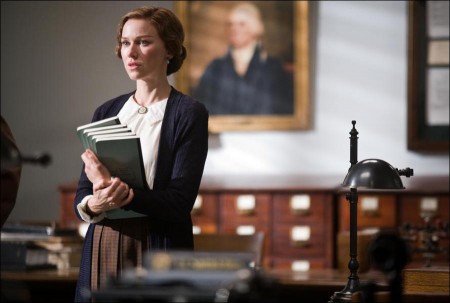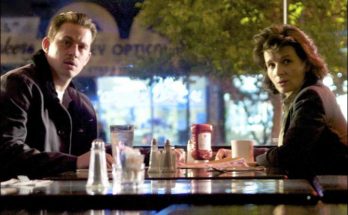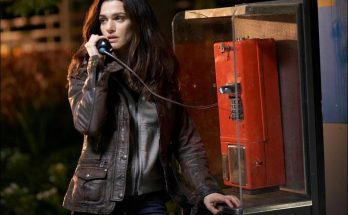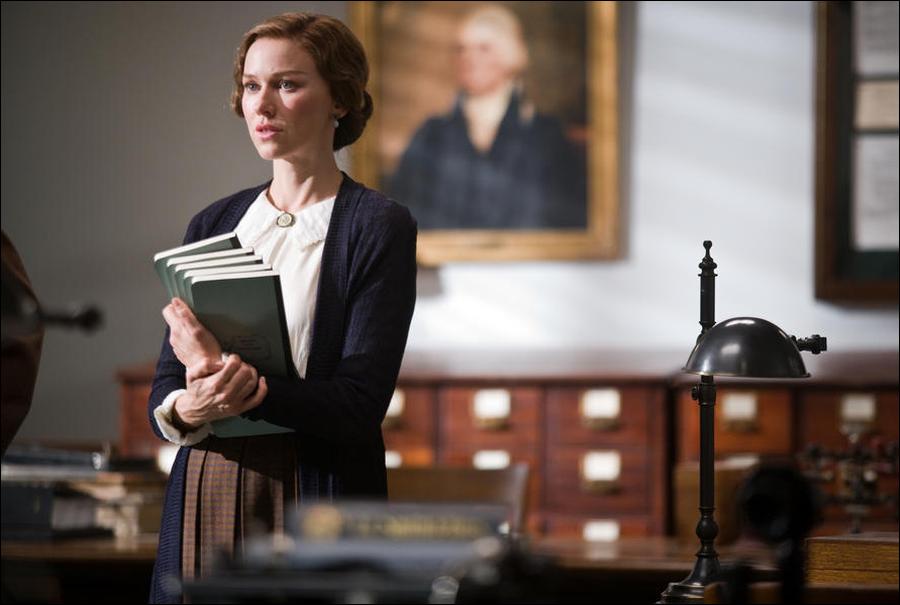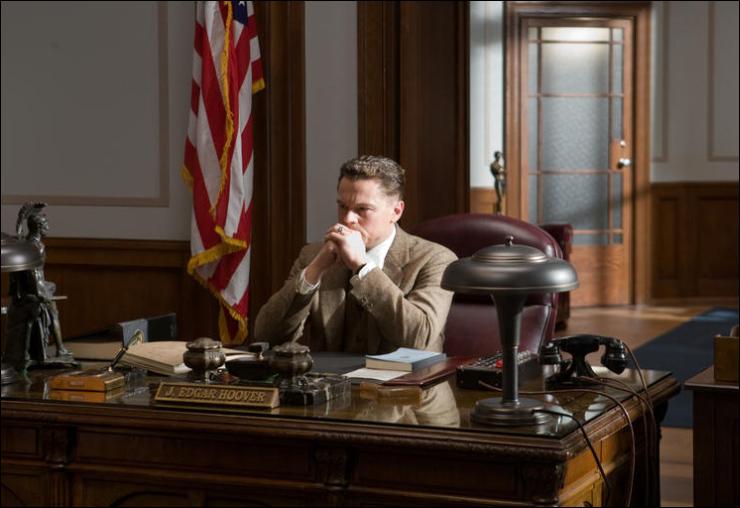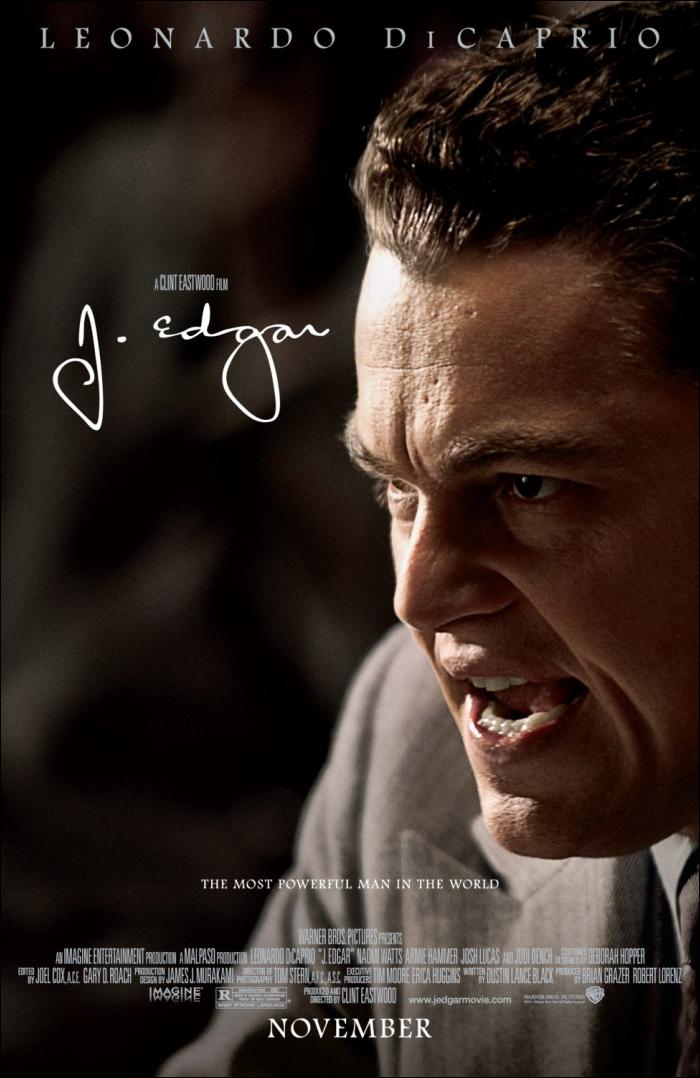Taglines: The most powerful man in the world.
J. Edgar is an American biographical drama film directed, co-produced, and scored by Clint Eastwood. Written by Dustin Lance Black, the film focuses on the career of FBI director J. Edgar Hoover from the Palmer Raids onwards. The film stars Leonardo DiCaprio as the title character, Armie Hammer, Naomi Watts, Josh Lucas, Judi Dench and Ed Westwick. J. Edgar opened the AFI Fest 2011 in Los Angeles on November 3, 2011, and had its limited release on November 9, followed by wide release on November 11.
“J. Edgar” explores the public and private life of one of the most powerful, controversial and enigmatic figures of the 20th century. As the face of law enforcement in America for almost fifty years, J. Edgar Hoover (Leonardo DiCaprio) was feared and admired, reviled and revered. But behind closed doors, he held secrets that would have destroyed his image, his career and his life.
About the Production
I don’t have to tell you that what determines a man’s legacy is often what isn’t seen…
J. Edgar Hoover was a complex and compelling figure who captivated America and whose legacy is still felt in the halls of the FBI building named for him. He was the catalyst for modern forensics and created a system of federal laws that transformed our country in a multitude of ways that remain relevant today. Both feared and revered, the man was a dichotomy whose public and private lives would spark rumor and innuendo, but, thanks to his eternal secrecy, the question of who he really was remains largely speculative to this day.
Director Clint Eastwood, who grew up during his reign, was intrigued by the chance to explore Hoover on film. “Hoover was a top cop, or a top ‘G-Man,’ as they called them in those days, but I didn’t really know much about him. He kept a high profile—he was seen with movie actors and famous writers at social gatherings and what have you—but he was an enigma in many ways.”
Therefore, when the screenplay for “J. Edgar” crossed his desk, the filmmaker says, “I was already curious, especially about how the screenwriter, Dustin Lance Black, had approached it. It was really a character study. I liked the story a lot.”
The film’s star, Leonardo DiCaprio, agrees. “Lance wrote this incredible screenplay that both Clint and I were attracted to instantly. Hoover has always been this mythic, iconic figure in American history, yet somewhat shrouded in mystery in both his political and personal life. To tackle his life story seemed daunting, and Lance did it in such an emotionally moving way.”
“This is a story about relationships,” Eastwood says, “intimate interactions between Hoover and everyone around him, from those closest to him—Clyde Tolson, Helen Gandy, his mother—all the way to Robert Kennedy and other well known political figures, even presidents. If it had just been a biopic, I don’t think I would have wanted to do it. I like relationship pictures, I like exploring why people do or did certain things in their lives.”
The director also looked forward to working with DiCaprio for the first time. “Leo’s very bright and he likes doing offbeat parts that stretch his imagination,” he says. “I knew this one would be tough, both mentally and physically, but he was very dedicated, and I think that really shows in his performance.”
“This was one of the most challenging characters I’d ever seen on the page,” DiCaprio says of Black’s script, which spanned Hoover’s entire professional life, beginning with the Bolshevik invasions in 1919, when communism was arriving on American soil. “Communism was almost like a terrorist movement in Hoover’s eyes, and he battled it and other perceived enemies throughout his career. Lance analyzed him as a young man and an old man, critiquing him in every possible way.”
“Coming off of ‘Milk,’ Hoover was someone I really wanted to investigate,” writer Dustin Lance Black states. “To me, he seemed the very opposite of Milk: a man with tremendous political power, but intensely closeted when it came to his personal life.”
The project came to Black through veteran producer Brian Grazer, who had worked with Eastwood once before and was eager to do so again. “I wanted to do a movie about J. Edgar Hoover—not a documentary, but an actual feature film,” he relates. “I was interested in the power and corruption that existed in his world, much of it of his own making, in spite of his being such a dedicated patriot.”
Black and Grazer settled on a few key points on which to center the film, including the Lindbergh kidnapping and the formation of the Federal Bureau of Investigation.
“I really wondered how this man, who started out with the best of intentions and went on to create the FBI and bring down some of the country’s most iconic gangsters, became so paranoid and, by some accounts, diabolical,” Grazer says.
Black notes, “My initial research labeled him either a hero to the nation, to whom we owe everything in terms of our protection and safety, or a villain who did things in an underhanded manner and was a terror to the country. It all seemed so extreme; I thought the truth had to lie somewhere in between.”
Grazer agreed with that conclusion, and with the writer’s idea to “present it from an internal point of view, from Hoover’s own psyche, letting him tell the story as he remembers it,” the producer says.
Producer Robert Lorenz felt that the subject was a particularly fascinating one because, he remarks, “What most of us know today is basically hearsay. This was a chance to put him in context; to attempt to understand what motivated his actions, without defending or judging everything that he did; to show that he was a complicated man, not a one-dimensional individual.”
After reading almost everything that had been published on Hoover, Black set off to track down as many firsthand accounts as possible from those few people still living who had known him. He filled in the picture with information from others who may not have known the man personally but lived in Washington, D.C., during his period in office, in order to get a full picture of him, the good and the bad.
Proving the axiom that history tends to repeat itself, the filmmakers found Black’s story of J. Edgar Hoover very timely, despite the fact he died nearly 40 years ago.
“One of the aspects of the script that was very appealing was the fact that it was about a guy who was really working to manipulate the media, and had a very shrewd ability to do that,” Lorenz observes. “In this age, when people are constantly trying to shape their images and are having to fight an uphill battle against the fast pace of technology, I think it’s fascinating to look back at how Hoover did it, and how he managed to keep so many things secret in his private life and his work. That type of privacy would be difficult, if not impossible, today, and was certainly one of the more intriguing aspects of making the movie.”
“J. Edgar” begins in the mid-1970s, when Hoover is nearing the end of his life and his time as Director of the FBI. Wanting to preserve everything he’s built, he begins dictating his memoirs, reflecting back on his early days as a man in his early twenties, when he first began working with what was then simply the Bureau of Investigation.
“I think he was interested in his place in history,” Eastwood surmises, “but probably prone to some exaggeration. There are proven moments where he fudged his stories a bit to make himself look a little better.”
Early on in his career, solving the Lindbergh case and capturing outlaws like John Dillinger helped Hoover to fashion the G-Man image in the eyes of the general public,” DiCaprio adds. “There were comic books about them, they were on cereal boxes, engaging America’s youth. It was all part of his publicity campaign to turn government into a force that was helping your family and keeping your children safe.”
Whether or not Hoover was ever able to feel the country was safe or that positive changes were on the horizon, is still a question. “I think even as an old man, J. Edgar Hoover was still so obsessed with communism that he didn’t recognize things were changing for the better during the Civil Rights Movement,” the actor goes on. “He saw it as an uprising that had the potential to become something more destructive. That’s when he lost his footing. That’s when he failed to see the real future of our country.”
Old Hoover
What’s critical at this moment is that we RE-clarify the difference between villain and hero.
J. Edgar Hoover devoted himself to public service, essentially putting aside any personal relationships he might have wanted to have for what he considered to be the greater good. As one who served to gain authority as well as the public’s adoration, he saw his opportunity to achieve both by positioning himself as a supreme crime-fighting figure, a hero of the populace.
“Hoover was incredibly ambitious as a young man,” says Leonardo DiCaprio, who took on the character that would take him from a man in his twenties to one at 77. “He was highly motivated to succeed in Washington, primarily due to his mother’s expectations of him. His father had failed to become a major political figure, and Annie wanted her son to carry the family name to great fame and fortune, with little or no regard for what else Edgar might have needed for himself. He became this stoic, bulldog enforcer who had to keep his personal life very personal. He became all about secrets.”
With so little known about the man’s inner life, DiCaprio did vast amounts of research in order to create a fully realized Hoover on screen. “It was a terrific challenge to breathe life into this person, because he was such a mystery,” he says. “I did find that he was very manipulative and very charming; he could charm anyone in the room but at the same time intimidate them. He liked the spotlight, but he concentrated so much on work that it defined much of who he was, his morals, the decisions that he made on really every level. I hesitate to use the word priest because J. Edgar Hoover was no priest, but he certainly looked at the FBI as his church.”
“Leo is a total professional, he comes completely prepared,” Eastwood says. “From the start, I could see he’d done all of his homework, thought a lot about what he had to do, and was interested in my take on things. I was really impressed by his focus, and I think it translated into the character.”
The actor was thrilled to be working with the legendary director. “Clint’s process is impeccable because he trusts his own instincts, he trusts his gut. There’s a beautiful simplicity to the way he works; he has one vision, which made it easier to do my job. He’s really like a corner man. It was like going into the ring and having your coach there, backing you up. And I think that confidence and support are evident on the screen.”
Trust was vital to J. Edgar Hoover, though he bestowed his on only a few individuals over the course of his lifetime, those few he felt were truly loyal to him. In order to paint a complete portrait of the man, it was critical to the filmmakers to capture those key relationships that helped reflect and reveal who he was, beginning with his colleague and friend, Clyde Tolson.
From Grazer’s perspective, “The relationship these two men had was one of companionship and joy, but also loneliness and isolation. They were both a product of their time.”
DiCaprio says, “They ate lunch and dinner together every day, went on vacations together. Whether they were together in any other respect…well, no one living knows the truth. In the film, it’s seen as almost an unrequited love, but a lasting one, nonetheless.”
Cast in the critical role of Clyde Tolson, Armie Hammer says that, whatever their personal relationship, “Clyde was always dutifully by the Director’s side, literally his right-hand man. That was just the way they operated.”
“Armie was terrific as Tolson,” Grazer states. “He was so polished in the part and brought a very subtle but tangible energy to the role, and he had a very natural rapport with Leo.”
Though there was not nearly as much information to be found about Tolson as there was Hoover, Hammer dug deep to learn about his character. “I hired a professional researcher, and she helped me find everything that’s out there on Tolson, even his junior high school year book,” he says. “According to some of the old FBI guys he was very observant, often the smartest man in the room. He was nicknamed ‘the human computer’ because he had a photographic memory. So even apart from any attraction there might have been, it’s easy to see why Hoover would rely on him so heavily.”
Another lifelong ally whom Hoover knew would never betray him was his secretary, Helen Gandy. “Helen kind of ran the agency,” Eastwood contends. “If you ask the old-timers, whenever you wanted to know something, you went to see her. She had much more information than anyone else.”
“Helen’s commitment to Edgar never faltered,” says Naomi Watts, who portrays her in the film. “I think she was initially impressed by him and found him clever and charismatic, but she was only interested in a career. She worked closely with him longer than anyone, through incredible changes in the world, and she remained steady and poised till then end.”
For the Australian, playing a deeply patriotic American in a film about one of the country’s most controversial figures was enlightening. “I knew nothing about my character, and very little more about Hoover, when I took the role. Not being a part of America’s history, and then not having lived through those times, made this a great learning experience for me.”
“Naomi did such a fantastic job,” Lorenz states. “The role was an understated but important one in the film, and she really made the most out of every scene and elevated the character, which was fitting for the role that Helen Gandy played in Hoover’s life.”
One woman who was not content to stay in the background of her son’s life was Annie Hoover. A domineering force, she wielded great influence over him and served as his measure of a moral high ground. Hoover lived with her and turned to her for guidance at every stage of his life, until her death when he was 43.
The venerable Judi Dench brought her to life in such a way that “you were able to love her and fear her at the same time, and she never even raised her voice,” says Grazer.
“She was really the kind of mother you don’t want around,” Dench comments. “She was very opinionated, and unbelievably possessive of Edgar, though she had three other children. I think she wanted not only the best for him, but beyond that, as if his accomplishments were a reflection on her. She reminded me a bit of Lady MacBeth. I think she wanted to be associated with the greatest man in the land. Edgar didn’t stand a chance, really.”
Despite both their long careers, this was the first opportunity Eastwood and Dench had to work together. The actress was thrilled to get the call. “He’s a legend,” she smiles, “so when he rang me up, my voice went up several octaves. I thought, ‘I’ve waited 75 years for this.’” That sentiment went both ways. “Judi’s a terrific lady, I’ve always been such a great admirer of hers,” Eastwood affirms. “She was my only choice for this role, so I’m certainly glad she didn’t turn me down.”
As seen in the film, one of the most pivotal cases in Hoover’s career—and the one his mother applies the greatest pressure on her son to solve—would come to be known as the crime of the century: the Lindbergh kidnapping. The case was particularly important to the Bureau because it helped to highlight its value in creating and enforcing federal laws. It also established a framework for collecting and testing forensic evidence from a crime scene, and ultimately played a significant role in Hoover’s ability to persuade Congress of the need to centralize such information.
At the time, Charles Lindbergh was, as Hoover advises a young agent in one scene, “the most famous man in the world.” DiCaprio says, “Hoover—as much or as little as he really had to do with it—certainly used the kidnapping to propel himself and the FBI to national fame.” Playing the famed aviator is Josh Lucas, who, coincidentally, has an ancestral connection to those early days of air travel.
“I jumped at the chance to play Lindbergh,” Lucas nods, “because my grandmother was a WASP—Women Airforce Service Pilots—during World War II, and also one of the first female commercial pilots in the country.”
Lucas began flying with her when he was a child, developing his own passion for aviation. “I read a biography of Lindbergh about 10 years ago, and felt such a real connection to that period and to the character because of my family and my own interest in flying, which I’m learning to do, slowly but surely, over the years.”
Also in roles connected to the Lindbergh case are Dermot Mulroney as Colonel Schwarzkopf of the New Jersey State Police; Stephen Root as wood expert Arthur Koehler; Denis O’Hare as handwriting analyst Albert Osborne; Zach Grenier as John Condon, the man who contacted the kidnapper; and Damon Herriman as Bruno Hauptmann, the man ultimately convicted of the crime.
And seen throughout the film in key moments from Hoover’s career are Ken Howard as Attorney General Harlan Fiske Stone; Jeffrey Donovan as Robert Kennedy; Jessica Hecht as communist activist Emma Goldman; Lea Thompson as Ginger Rogers’ mother, Lela; and Geoff Pierson as Hoover’s first boss at the Bureau, Mitchell Palmer.
Young Hoover
Imagine if every citizen in the country was uniquely identifiable with their own card and number, say, the pattern on their fingers. Imagine how quickly they could be found when they committed a crime.
J. Edgar Hoover lived his entire life in Washington, D.C. But as the filmmakers began scouting for the production, “it occurred to us that we could film almost everything in California,” Lorenz says. “There was only one element that we knew we’d absolutely have to go back to Washington for, and that was the Library of Congress. I was familiar with it, but had never really taken a close look. So when I saw it in the script, and did a little research, I realized why Lance Black chose that location for the scene where Hoover is trying to impress Helen Gandy. It’s just a magnificent piece of architecture.”
“It’s such an impressive place, you want to photograph it,” Eastwood shares. “The moment we walked in and looked up, we knew we’d have to try for it, for whatever part of it they’d make available to us.”
Despite the fact that the building is open to the public, production designer James J. Murakami was pleasantly surprised by the access granted to the production. “It’s just a grand, beautiful building. It was amazing, the historical significance, especially considering why we were there. The files under the mezzanine actually contained cards with Hoover’s handwritten notations on them.”
Other doors that opened for the filmmakers were those to the Federal Bureau of Investigation, as well as the Department of Justice, where the FBI was housed throughout Hoover’s tenure. Lorenz recalls, “The FBI and DOJ were very cooperative and helped us to see all that Hoover saw during his time. We probably could have gotten permission to film in Hoover’s offices if it weren’t for the fact that we had so much to shoot there. It would have been too much of a burden on them to use the space for as long as we needed it. But we did shoot from his balcony in order to get the integral point of view shots that we required.”
In order to convey to a movie audience Hoover’s perspective from his office overlooking Pennsylvania Avenue, visual effects supervisor Michael Owens and his team stepped in to create period versions of the street at different times, including inaugural motorcades of two presidents, Franklin D. Roosevelt and Richard Nixon.
“The period look came from our research,” Owens relates. “We photographed the real locations and then modified them. Modeling, texturing and building a lot of these environments in the computer allowed us to create a look much more easily than building a whole set.”
To replicate the places Hoover spent much of his time, Murakami and his team built practical sets, such as the vast hallway and several offices of the DOJ, on cavernous Stage 16 at the Warner Bros. Studios lot. “The main corridor alone was 13 feet wide, with 18-foot ceilings, and had to be about 120 feet long to accommodate the action.”
But that wasn’t the designer’s biggest challenge. “The terrazzo flooring at the DOJ couldn’t be recreated using the very expensive real materials, so we ultimately decided to do it using a new digital method. We photographed the real floor, and then printed it onto MDF board.”
Murakami did extensive research in order to recreate the offices on the soundstages, which had to be adjusted to suit each of the different eras covered in the film, spanning from 1919 to the early 1970s. The design department accomplished this by focusing on the details that would naturally have been updated over time, such as light fixtures that evolved from incandescent to fluorescent.
“We took liberties where we had to, but tried to make everything look and feel as authentic as possible,” he says. Several sets his team built doubled for others with a new coat of paint, different furnishings, repositioned walls, and so forth. For example, the set for Robert Kennedy’s office became a smaller bureau office, and was then repurposed as the crime lab.
Hoover’s house, which he lived in all of his life, was a key set for the production, as many of the film’s critical scenes take place in his home. With regard to dressing the various rooms, Murakami says, “He collected everything. His house was filled with tchotchkes, including a lot of Chinese statues and screens, and many things that had been in his family since he was a child.”
For scenes in which Hoover and Tolson attend the horse races—both as young and old men—the creative team reviewed video of the Pimlico track in Baltimore, Maryland, and Del Mar in Southern California, then reproduced a section of tiered box seats, making adjustments for the differing looks of each location as needed. Director of photography Tom Stern used medium and tight shots on the actors as they “watched” the races, with a green screen behind them that would allow for a CGI background of the appropriate environment integrated with footage of the different races.
Off the lot, various Los Angeles locations stood in for some of the story’s locales. The Cicada Restaurant, located downtown near Pershing Square, served as New York’s famed Stork Club. The scene called for a band, so the director called upon son Kyle Eastwood and several of his musician friends to perform what would be the only live music in the film.
Elsewhere around town, the men’s department of Garfinkel’s was recreated in a portion of a downstairs ballroom of the historic Park Plaza Hotel. The hotel also became the site of the United States Senate Chambers. Olvera Street’s Pico Building was transformed into the Kansas City Railroad Station.
For the scenes involving the Bruno Hauptmann trial, the production traveled a short distance south of L.A. The old Orange County courthouse in Santa Ana, which was built in the early 1900s and which is now a museum, matched almost perfectly to the New Jersey courtroom where the trial had taken place. The exteriors for that scene, however, were shot in front of a quaint courthouse in the town of Warrenton, about 40 miles outside of D.C. The Plains, also on the outskirts of the nation’s capital, provided the perfect environment for the Lindbergh estate, and the architecture of certain neighborhoods in Arlington, Virginia, offered the right look and feel for other exteriors in the film.
“Every single scene was something new, calling for a new set, a new time period,” Lorenz recounts. “But if there’s anybody that could do it, it’s Jim. He and his team, along with Michael Owens’ crew, really understand how to fit all the pieces of a puzzle together.”
INT. HOOVER’S OUTER OFFICE, REVEAL: standing across the room behind a mahogany desk is a stout old man with a mashed-in nose, wearing a three-piece suit. This is Hoover, almost 40 years later, now J. EDGAR HOOVER.
“J. Edgar” takes place over the course of more than six decades, from the early 1900s to 1972, requiring the costume designer, Deborah Hopper, to create costumes that captured the changing times. Leonardo DiCaprio alone had almost 80 costume changes, which presented quite an exciting challenge to Hopper and her team.
“Hoover himself was impeccable,” Hopper observes. “Even though he didn’t have as many clothes early on in his career, he was always professional looking and meticulous, and he insisted his agents be the same. He had a certain image in mind for the FBI.”
Producing costumes for such a large cast and expansive timeline took a great deal of planning. “At least some part of the story takes place in almost every decade of the 20th Century, but moves back and forth in a non-chronological way,” Hopper states. “So in addition to dressing the cast in styles appropriate to the period, I felt my job was to help provide the audience with a subtle guide to where they were at any moment in Hoover’s lifetime.”
Hopper worked out a color scheme to communicate subtle visual cues. “I thought it would be easier to have a different palette for Hoover in the various eras, beginning with brown, nubby fabrics with texture for the 1920s; shades of gray and navy blue with a bit of striping and texture in the `30s; and then smooth, solid fabrics in navy, gray and dark brown in the `60s. In that way, the clothes help tell his story.”
As Hoover climbed in his career, his style began to change, especially after he met the more dapper Clyde Tolson. “When he was younger and wearing the brown tones, we put him in single-breasted suits,” she recalls. “Then in the `30s, Tolson took Hoover to his tailor at Garfinkel’s. For the first time, J. Edgar had a double-breasted suit, made specifically for him and styled by Tolson.”
Of course, Hopper also had to design a look for Tolson, who was “a bit more stylish. We used more stripes and always added cuff links, tie tacks, pocket squares, watch fobs…completely accessorized. Hoover and Tolson were obsessed with their images and always dressed very well.”
In addition to dressing the gentlemen, Hopper had to create a look for Naomi Watts’ character, Helen Gandy, which would span the same amount of time and offer clues to her style as well. “In the `20s, when she first meets Hoover, we gave her a bit of a flirtatious, feminine look, using a bit of lace,” she says. “As the years went on, she became a bit more businesslike, and by the time we got to the `60s, it was all suits.”
“Deborah was splendid,” says Eastwood, “but she’s always splendid. She always does a great job. But I think she had a good time because she got to do not only so many different periods, but very glamorous times in American history.”
In her research, Hopper first sought out real period clothing at the various costume houses in Los Angeles to use as a guide. And because there is only so much vintage fabric in existence, Hopper and her team had to work with some modern materials, distressing them to match the original pieces. “We didn’t want to make them look used, per se. We just softened them so they looked like the character had worn them for a while.”
Just as the clothes had to age, so did the characters, presenting Hopper and the make-up team with the job of helping to transform certain cast members as the years passed.
“We put padding on Armie and Naomi as their characters got older,” Hopper says. “For Leo, we molded latex onto his body, so it felt like his own body. He wore less for the `30s, and we added more for the `60s, including arm pieces. Of course, we had to adjust the costumes to the new body shape. Image was important to Hoover, and it took a great team to create ‘J. Edgar’ at every age.”
“To take somebody from his mid-twenties to his seventies is an interesting challenge,” remarks make-up artist Sian Grigg, who supervised the process for Leonardo DiCaprio. “Leo was never going to look exactly like Hoover because he has a totally different face, but he has a great face to work with, and I believed it would be possible to give him a strong resemblance to Hoover without it being distracting. We put in contact lenses to make his eyes dark brown. His hair stylist, Kathy Blondell, dyed his hair brown and added gray hairpieces at various stages; she even plucked out some of the hair in his widow’s peak to give him a squarer hairline. For the younger looks, I used mouth appliances to help change the shape of his face, applied a prosthetic neck appliance to give him a double chin, and inserted a nose augmenter to deform his nose a little bit, all to get him closer to looking like Hoover. But to get somebody as young as Leo to look like he is in his seventies requires full facial prosthetics, a full bald cap with punched-in hair—each of which could only be used once—and a toupee, and prosthetic hands as well.”
Grigg, who has worked with the actor for 15 years, says that for this film, DiCaprio had to suffer through the making of a full face plaster cast. “It’s not a pleasant experience at all, but in order to sculpt such fine work and make the pieces fit exactly, you must have a mold of the subject’s face at that moment in time. Duncan Jarman did beautiful sculpting work, which made it possible for us to do the rest.”
The overall effect was perhaps better than Grigg and her team could have hoped. Robert Lorenz remembers walking on the set with Eastwood, passing by DiCaprio, who was in full oldage prosthetic make-up, but still dressed in his own clothes. “It was the first day we were shooting him older, and Clint hadn’t seen him yet,” the producer says. “And he walked right past him. He didn’t even realize it was Leo.”
Eastwood appreciated the effort Grigg and her team put in. “Leo’s make-up was extraordinary. I think they did a phenomenal job creating his face. You really felt that you were in the presence of J. Edgar Hoover.”
Leonardo DiCaprio relates, “I think what allowed me to really get a real sense of this man I was portraying was that, at its heart, ours is a story about the person inside. Lots of stories have been told about Hoover, but I feel that his relationships with Clyde Tolson, Helen Gandy and his mother really forged who he was for the entirety of his life and career. That was what compelled me to go to work every day, and it’s what I hope will intrigue people as they watch the movie.”
“Hoover was fearless and articulate, and those qualities, along with the countless secrets he held onto, kept him in a position of power for almost half a century,” Brian Grazer reflects. “But on the flip side, the more you try to hold onto power, the more it slips away, and I think the lessons to be learned from Hoover’s life are ageless, and his story as powerful and emotional and vital today as it was during his time.”
Director Clint Eastwood says, “What made the story so interesting and, I hope, carries over to the movie, is that you get to know Hoover well enough that you understand him, his love for his mother, his need to protect the country, his relationship with Tolson…all the things that make up a life. He was more than the Director of the FBI, he was a complex guy. I hope we can draw people into his world so that, for a couple of hours, they see history through his eyes.”
J. Edgar
Directed by: Clint Eastwood
Starring: Leonardo DiCaprio, Judi Dench, Damon Herriman, Naomi Watts, Josh Lucas, Lea Thompson, Dermot Mulroney
Screenplay by: Dustin Lance Black
Production Design by: James J. Murakami
Cinematography by: Tom Stern
Film Editing by: Joel Cox, Gary Roach
Costume Design by: Deborah Hopper
Set Decoration by: Gary Fettis
Art Direction by: Greg Berry, Patrick M. Sullivan Jr.
Music by: Clint Eastwood
MPAA Rating: R for brief strong language.
Studio: Warner Bros. Pictures
Release Date: November 11, 2011
Hits: 86

